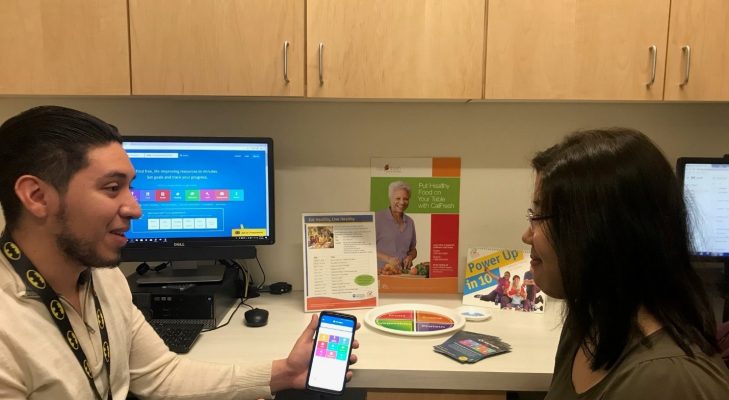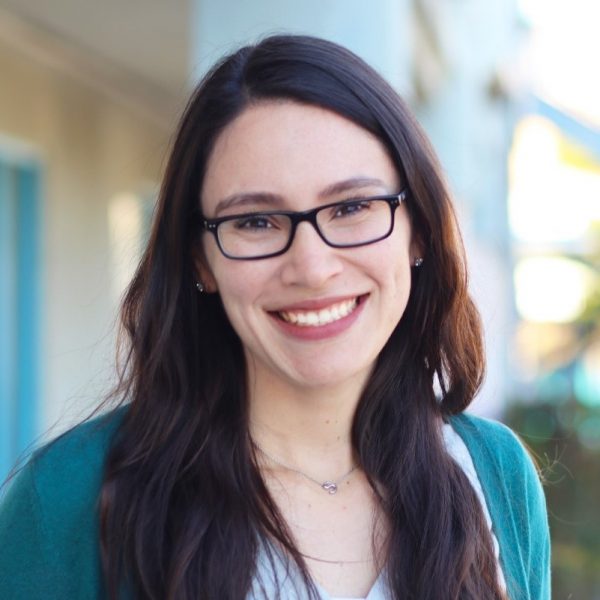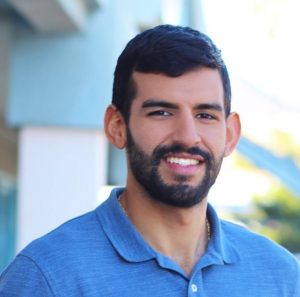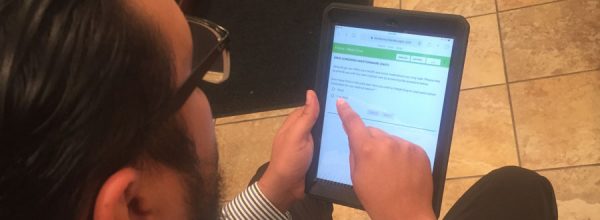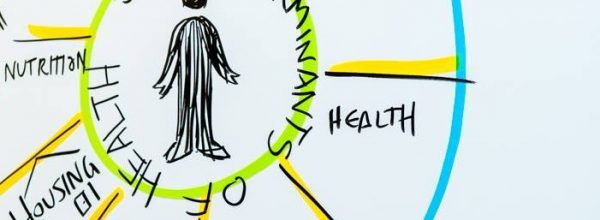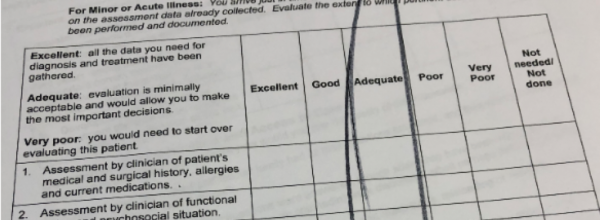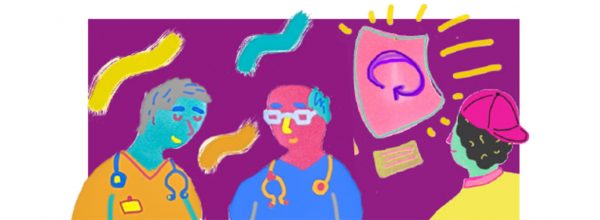Innovative and dedicated, NEVHC was recently in the news for helping turn a small homeless shelter in North Hollywood into a large, sunny campus that combines a homeless shelter with a family center, permanent housing, healthcare and dental care for thousands of people now living in shelters or on the street. Known as the LA Family Housing campus, it will also offer office space for housing navigators, job counselors, legal aid, and others. One of the donors, Brie Dorfman, said the family housing was unusual because it “focuses on rebuilding people’s lives – not just by giving them a home, but by creating opportunities for them.”
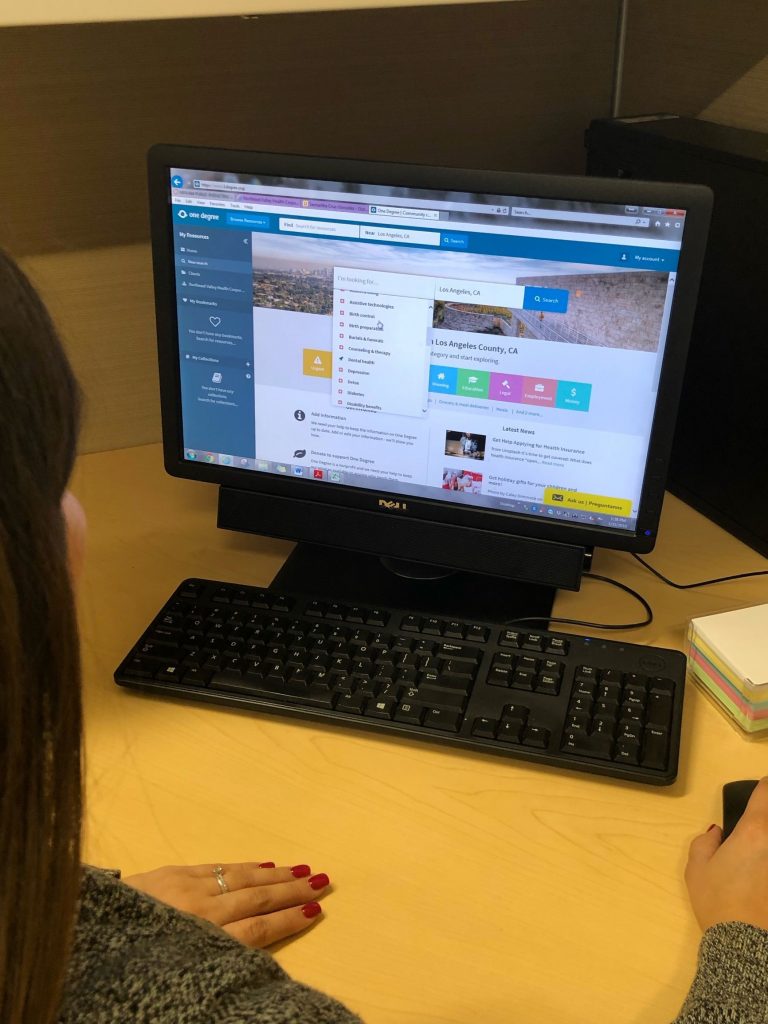
NEVHC studying One Degree platform (Credit: NEVHC)
Partnering with One Degree
But even the new LA Family Housing campus can’t serve the urgent social needs of all the impoverished residents of Los Angeles served by NEVHC, especially those in far-flung counties. To help residents struggling with everything from hunger to a place to live, staff members at many clinics have long given out paper handouts referring people to food banks, homeless shelters, and other resources. But King, NEVHC’s associate director of health education, was looking for a more systematic approach to meet patients’ needs.
Low-income Northeast Valley patients have more than their share of challenges to managing their health, according to King. This may include everything from not having a store nearby that sells fresh produce to not having a way to get to their medical appointments. Some people can’t store their medications properly because they’re homeless. “We did not have a systematic approach to assess or respond to our patients’ SDOH needs,” King said. “Often staff were working in silos, using outdated resource binders. And some were not aware of available resources, so they avoided patients’ underlying needs all together.”
To improve their referrals, King and others turned to One Degree, a social service referral platform often called the “Yelp” of community services. After meeting with One Degree, Northeast Valley did a careful, in-depth evaluation to get buy-in and bring the project alive. Soon after One Degree demonstrated the platform to NEVHC leadership and end users, King and her team surveyed staff to identify what resources they most commonly used for emergency food, housing, clothing, jobs, legal help, and so on. They interviewed care coordinators one by one about resources for everything from food insecurity to social isolation.
“We also did patient surveys, asking what resources they often used or had heard about—we collected a lot of 1,000 patient surveys, in all,” King recalled. Based on its findings, the NEVHC team began to create customized “Collections” (aka favorite lists) on One Degree (see sample resource page below).
“Peeling the onion”: Uncovering barriers to care while vetting the referrals
The team then began vetting the collections. It made on-site visits to food banks. It sent out a questionnaire via SurveyMonkey to everyone who did referrals to social services. It also sought help from the NEVHC’s Patient & Family Advisory Committee. It was an eye-opening process, and along the way, the team discovered some unexpected barriers to care.
One involved transportation: NEVHC had had arranged patient transport service via Uber and Lyft for people who were disabled or had no car, but with disappointing results. The patient focus groups held a clue as to why. “We found when we peeled the onion a little, there were so many logistical problems – either the drivers had such a large window or they wouldn’t pick [patients] up,” said King. “One elderly patient rented in a garage in back of a house, for example, and the owner didn’t want the driver coming through the yard to pick her up.”
Reflecting on the findings, King said that “since we had made the transportation benefit available, we thought we didn’t need to dig deeper. But when you actually try to implement something, you find all the barriers that are accruing.”
There were more surprises in the area of emergency food. The team learned from patient focus groups there was a stigma around the phrase “food banks” – patients found headers such as ”free groceries” more inviting. They also heard reports that one food pantry tended to stack the good produce on top of the $30 food boxes it gave out, but underneath the food was spoiled. “We let them know of those reports and why we were taking it off our resource list, and the pantry later came back and said they had made a lot of changes,” King said. “It really had revamped its offerings – the food was fresher and they let people choose the food they wanted — so we were able to add it back to the list.”
Co-designing an online referral solution
The team went on to create a short-cut to access the One Degree platform via NEVHC’s Electronic Health Record (EHR), so that the enrollment process was semiautomated. “The enrollment process takes our employees to a third-party site, where they can log in, look up a client, and pull up all their demographic info (phone number, address and so on), then click “enroll” and it will take them to the One Degree platform,” King explained. “Once you do that, you bring all the patient information into the One Degree platform, which is HIPAA compliant — and put all the contact info there.”
With input from community health workers, NEVHC developed a workflow that included introducing the platform to patients, enrolling them, initiating referrals and doing follow-up. Leaders met monthly with community health workers, some of whom had mixed feelings about the new referral system.
“When we first introduced the One Degree platform, community health workers would often say “my patients cannot use technology” and “they do not want to enroll in the program,” King reported. “We did a lot of listening.” After reporting the feedback to One Degree, she and other leaders were pleased at how responsive the organization was. Since patients had complained of being bombarded by texts, One Degree made the messaging and frequency more patient-friendly. The organization cut back on the number of texts sent to patients, including the staff’s name and role in the messaging, and modified the print handouts to look more visually appealing.
“Some staff adopted early; with some it took longer,” King recalled. During the monthly meetings, leaders also talked about different ways to introduce the platform to patients. “For example, instead of having the patients ‘opt in,’ we suggested the staff ask patients, ‘Would you like to receive the information about your referral via text message, e-mail, or handout?’” In October 2017, NEVHC rolled out One Degree to patients to use social service referrals.
“Client-sharing”: Closing the referral loop
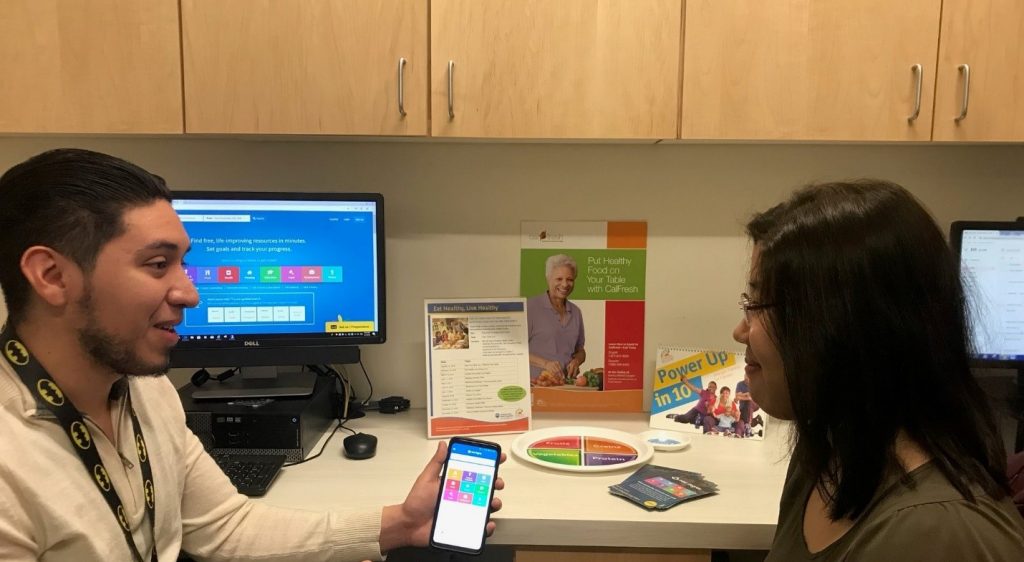
New client sharing feature in One Degree allows for cross team coordination of referrals. (Credit: NEVHC)
The staff started hearing some good feedback almost immediately. But although the platform allowed staff members to track the status of referrals made to their clients – an important gain – it did not allow them to share clients with other staffers. “What this meant was that a case manager was able to add patients to her case load, but her coworkers couldn’t see them,” King said. “For this reason, you might have duplication or difficulties for other team members trying to follow up with the patient.”
In the fall of 2018, Northeast Valley received funding from the Center for Care Innovations to create a new “client sharing” feature on the platform. This way case managers and others could see not just their own clients, but all the patients on the platform.
After the new feature was rolled out, it was time to test it. The staff and patients tested it out uncovered some glitches, which were reported back to One Degree. After the online referral solution fixed the glitches, NEVHC staff members re-tested the feature until they were satisfied.
Goals
Northeast Valley leaders implemented One Degree with the goal of better understanding and addressing the SDOH needs of its patients and community. They also wanted to find out how successful their staff had been at linking patients to community resources using the new One Degree feature allowing cross-team communication. They had these goals for their use of the One Degree platform:
- At least 10% of the referrals made would have a “utilized” status in One Degree
- At least 80% of the patients who had SDOH needs would receive a referral via the One Degree platform
- At least 20 patients would be co-managed by two or more staff (to test how well the new “client sharing” feature was working)
- At least 80% of the end users would be satisfied with the new client sharing feature of the platform.
The staff also trained additional NEVHC staff on the platform and created “achievable goals” based on their needs. The One Degree tool also sparked thoughtful conversations on how to use patient-centered communication, decrease bias, and create realistic actions plans with patients.
Results
Within 30 days in March 2018, community health workers had enrolled 80% of their patient caseload onto the platform and all-time referral use jumped from 6% to 25%. But the staff were most impressed that One Degree had improved the platform based on the feedback they provided. During every meeting, the staff reports, they now share resources and ensure new ones are available on the One Degree platform.
“One Degree creates a centralized place were everyone can share the same resources,” King explained. Among the outcomes:
- More than 40 NEVHC staff work with the One Degree platform, with those who provide community resource referrals and case management using the platform at multiple sites.
- Staffers have used One Degree to serve nearly 700 patients, making more than 1,200 referrals to over 140 different community-based organizations.
- Of the patients who have received referrals, more than 20% have created their own One Degree account to manage their social service referrals.
“Our auditors were very impressed with One Degree and its use of up to date resources,” said King. “That is a win for staff – they don’t have to manually go through their binders all the time and update them.”
“We haven’t gotten rid of paper handouts, though,” King added. “Feedback from staff that many patients still want something tangible.” She noted that staff members still print out flyers, especially when they have specific information such as class schedules patients can’t always find on One Degree.

